- Apr 2020
-
www.scienceintheclassroom.org www.scienceintheclassroom.org
-
porcine
Lab testing relating to pigs
-
CD31-positive
A protein that is involved in angiogenesis activation.
-
cell-laden hydrogels
Hydrogels loaded with live cells.
For the paper, this is an appealing option that helps engineering potential tissue constructs with biomimetic structure and function. Cell-laden hydrogel is a promising scaffolding system for engineering artificial bone, cartilage, cardiac and neural tissues.
-
LIVE/DEAD staining confirmed high viability
Staining that is a fluorescence assay (as shown in image on Panel E) which shows cell viability, that is whether the cells are dead or live. The live cells emit green light where the dead cells emit red light.
-
thermoreversible
Whose properties can be changed back and forth by increasing or decreasing temperature.
For the article, specific thermoreversible hydrogels form a gel when cooled and return to a viscous fluid state when exposed to heat.
-
perfusion
The passage of blood or fluids through blood vessels or other channels in an organ or tissue.
In this paper, perfusion is needed to sustain healthy tissues and organs.
-
micro–computed tomography (μCT)
Micro-computed tomography (Micro-CT) is a 3D imaging technique utilizing X-rays to see inside an object, slice by slice. It is similar to a CT scan, but on a micro-scale. Micro-CT provides high resolution 3D imaging of the interior structure of materials and biological samples without having to cut the samples.
-
endothelial
cells that are on the inner surface of blood vessels
-
regurgitation
Leaky heart valves. A condition in which the heart valve doesn't close tightly, which allows blood to flow backward in the heart.
-
perfusable vascular-like networks
Artificial blood vessel structures through which one can flow fluids which nurture cell growth.
-
patent and manifold
Unobstructed (open inside allowing for fluid flow) and has several outlets to be connected to other tubes/pipes, similar to the arteries and veins in our body.
-
G-code
G-code is a language that humans use to tell a machine how to do something. With 3D printing, g-code contains commands to move parts within the printer.
-
micro–computed tomography
Micro-computed tomography (Micro-CT) is a 3D imaging technique utilizing X-rays to see inside an object, slice by slice. It is similar to a CT scan, but on a micro-scale. Micro-CT provides high resolution 3D imaging of the interior structure of materials and biological samples without having to cut the samples.
-
tri-leaflet valves
The aortic valve of the human heart typically contains three leaflets or cusps, hence called the tri-leaflet valve. When the valve opens it allows blood to exit the left ventricle into the aorta. Once closed, blood movement stops. In the case of a dysfunction, the tri-leaflet valve is repaired or replaced by a surgery. The technology described in this article provides a promising approach to create artificial implants for these surgeries.
-
pH-driven gelation
Hydrogels are 3D networks of hydrophilic polymers that can hold a lot of water while still maintaining structure. They resemble tissue structure when scaffolded and can nurture cell growth and vessel formation. Hydrogels can be assembled by chemical processes. In this study, authors used pH-driven assembly (gelation).
-
micro–computed tomography (μCT)
Micro-computed tomography (Micro-CT) is a 3D imaging technique utilizing X-rays to see inside an object, slice by slice. It is similar to a CT scan, but on a micro-scale. Micro-CT provides high resolution 3D imaging of the interior structure of materials and biological samples without having to cut the samples.
-
-
www.scienceintheclassroom.org www.scienceintheclassroom.org
-
A negative Nb anomaly characterizing the involvement of subducted material is present in all the trace-element patterns of our studied samples. This anomaly implies that a recycled crustal component, and not the ambient mantle, dominates the trace-element budget in the fluid inclusions.
Negative Nb anomalies are characteristic of subducted material. Subducted material includes continental-sources sediments from the ocean floor that gets subducted into the mantle. The trace element patterns look more like the crust than the mantle, which means that the fluid inclusions' trace element record is not recording any mantle processes.
-
kimberlite
A kind of intrusive, igneous rock that is formed deep inside the Earth’s interior. Kimberlite tends to move upwards via the upper mantle and lower and upper crusts, ultimately reaching the surface of the Earth. When the rocks move up, they carry diamonds inside them, thereby becoming an important source of diamonds.
-
slab subduction
A slab is a part of the tectonic plate which undergoes subduction. Subduction is a geological phenomenon occurring at the junction between two tectonic plates. This involves pushing one plate below the other, so much so that the sinking plate (usually the denser one) protrudes into the Earth’s mantle.
-
mid–ocean ridge basalts
The mid-ocean ridge is one of the largest chain of volcanic mountains on Earth, with 90% of the mountains submerged underneath the ocean. A type of basaltic rock originating from volcanic eruptions in this region is known as mid-ocean ridge basalt.
Mid-ocean ridges occur where two tectonic plates pull apart and the mantle below wells up and then rapidly cools due to the interaction with the ocean's cold water. This is what makes up oceanic crust.
-
shallow crustal contamination
This occurs when magma inside the Earth's mantle gets polluted by small amounts of crustal rocks—that is, rocks from Earth's crust. Shallower crustal rocks are more felsic, which means they contain more feldspar and quartz.
-
-
www.scienceintheclassroom.org www.scienceintheclassroom.org
-
gastric resident dosage form
A pill that stays in the stomach during drug release.
-
ANOVA
Analysis of Variance - statistical test used to determine whether there are any statistically significant differences between the means of three or more independent observables.
-
extracellular fluid
Any body fluid outside of the cells in any multicellular organism. This includes interstitial fluid and plasma.
-
levonorgestrel-releasing gastric resident dosage form
A smart pill that stays in the stomach during release of a drug (levonorgestrel) which prevents pregnancy.
-
-
www.scienceintheclassroom.org www.scienceintheclassroom.org
-
electrostatic
an electric field/charge that is stationary
-
capacitor
a device that stores electrical energy between two conducting electrodes separated by a dielectric (nonconducting) material
-
Maxwell pressure
when a voltage is applied between electrodes pressure arises, the elastomer contracts in thickness and expands in area.
-
dielectric breakdown
occurs when current flows through a material whose electric charges do not flow freely
-
hydraulically amplified self-healing electrostatic (HASEL) actuators
A device which generates movement from electrical energy. The device consists of liquid segments which helps amplifying force generation and heals itself in case of an electrical breakdown.
-
Peak specific power
The peak specific power is the maximum power that the power supply can sustain for a short time.
-
- Mar 2020
-
www.scienceintheclassroom.org www.scienceintheclassroom.org
-
endoscopic overtube
An endoscopic overtube is a sleeve-like device designed for both upper and lower endoscopic procedures. During upper endoscopy it is designed to protect the hypopharynx from the trauma of repeated intubations, the airway from aspiration, and the esophagus during extraction of sharp foreign bodies.
-
pharmacokinetics
A branch of pharmacology which studies how drugs are taken up, distributed, metabolized, and cleared from the body.
-
Poly(sebacic anhydride)
A biodegradable polymer substance used in drug delivery applications
-
patient adherence.
A patients commitment (how well a patient follows prescribed directions) to taking said medication at the correct time each day.
-
poly(dimethylsiloxane)
A silicon based elastomeric polymer used in biomedical applications.
-
hormonal contraception
methods of birth control which impacts hormones related to pregnancy
-
in vivo
in live being
-
oral contraceptives
A drug or device used to prevent pregnancy taken as a pill by mouth.
-
-
www.scienceintheclassroom.org www.scienceintheclassroom.org
-
actuation
the action of causing a machine to operate
-
hydraulic
denoting, relating to, or operated by a liquid moving in a confined space under pressure.
-
soft robotics
a subcategory of robotics that deals with the construction of flexible robots to mimic living organisms
-
soft actuators
a lightweight, affordable, and easily customizable device component consisting of flexible material that converts energy into mechanical movement in order to move/control a part of the device
-
actuation strain
deformation produced by a non-mechanical stimulus
-
elastomer
a material that produces a large deformation when a voltage is applied
-
polymer fibers
man-made fibers consisting of synthetic chemicals
-
transducers
a device that converts an energy signal in to another form of energy signal
an example of this is mechanical energy being converted to electrical energy
-
ionically conductive polyacrylamide (PAM) hydrogels
a gel which contains significant amount of water and can conduct electricity
-
electrodes
an electrical conductor that makes contact with nonmetallic parts of a circuit
-
polydimethylsiloxane
the most widely used silicone based organic polymer
-
resonant frequency
Simply put, resonant frequency is the natural frequency at which it is easiest to get an object to vibrate. Most objects have several resonance frequencies, such as stringed musical instruments that vibrate at their resonance frequencies when plucked or struck, and their vibrations against the surrounding air produce sound. This type of resonance is found when an object is in equilibrium with acting forces and could keep vibrating for a long time under perfect conditions.
-
linear actuation
An actuator creating movement in a straight line, rather than a circular motion.<br> In this study, a fixed pre-stretch is applied in one direction (downward pull).
-
strain
the ratio of total deformation to the initial dimension of the material body upon application of external forces.
-
dielectric permittivity
this ability of a material to hold an electrical charge
-
fluidic actuators
a device component which uses hydraulic fluid pressure to convert energy into mechanical movement in order to move/control a part of the device.
-
-
www.scienceintheclassroom.org www.scienceintheclassroom.org
-
neonatal
Newborn child
-
cell infiltration
Migration of cells into microporous structures.
-
slurry
A semiliquid mixture, typically of fine particles of manure, cement, or coal suspended in water. E,g, cake batter
-
cardiomyocytes
Heart muscle cells responsible for contracting of the heart.
-
collagen scaffolds
Scaffolds provide support for tissues and organs in the human body. In this article, the scaffolds are made from collagen, a structural protein used in connective tissues
-
extracellular matrix
A network of biological materials surrounding cells throughout the body for protection and support.
-
cellular infiltration
The ability of cells to occupy the porous structure in the hydrogel to create a tissue-like structure
-
yield stress
Highest amount of force an object can take before deforming.
-
pH
A scale from 1 to 14 determining how acidic or basic a solution is. 1 is most acidic, 14 is most basic, and 7 is neutral.
-
fidelity
Reproducibility of features (size and shape) with 3-D printing
-
decellularized
cells removed
-
fidelity
Reproducibility of features (size and shape) with 3-D printing
-
resolution
Smallest feature that can be written by 3-D printers.
-
-
www.scienceintheclassroom.org www.scienceintheclassroom.org
-
graminoid
Grasslike plants.
-
physicochemical
Interactions of physics and chemistry.
-
hysteresis
When the direction of an ecosystem change cannot be reversed, i.e., an ecosystem cannot be returned to its previous state once it has gone through a phase shift.
-
predation
Killing other organisms for food.
-
interdisciplinary
Research involving more than one field of science, e.g., biology and chemistry.
-
biogeochemical cycles
Complex cycles of nitrogen, sulfur, phosphorus, carbon, and water involving the atmosphere, land, water, and organisms.
-
ecosystems
The interactions between organisms and the nonliving environment (i.e., rocks, water) within an area.
-
top-down forcing
The impacts that top-level predators have on the food web levels below them.
-
carbon sequestration
The storage of carbon atoms in organisms, soil, and water from the atmosphere
-
-
www.scienceintheclassroom.org www.scienceintheclassroom.org
-
continental plume–related basalts
When large stretches of land are covered by lava generated from a massive volcanic eruption, a type of basaltic lava is created. Sometimes, these eruptions are also caused by movement of tectonic plates in the lithosphere. Such events when combined with abnormally hot rock in the Earth's mantle (mantle plume), give rise to continental plume-related basalts.
-
degassing
It is the process of removal of dissolved gases from liquids, especially aqueous solutions.
-
- Feb 2020
-
ttu.blackboard.com ttu.blackboard.com
-
ACTIVITY 3: SYNCRHONOUS COMMUNICATION TOOLS
syn·chro·nous /ˈsiNGkrənəs/ Learn to pronounce adjective 1.existing or occurring at the same time.
-
ACTIVITY 2: ASYNCHRONOUS COMMUNICATION TOOLS
a·syn·chro·nous /āˈsiNGkrənəs/ Learn to pronounce adjective 1.(of two or more objects or events) not existing or happening at the same time. 2.COMPUTING•TELECOMMUNICATIONS of or requiring a form of computer control timing protocol in which a specific operation begins upon receipt of an indication (signal) that the preceding operation has been completed.
In telecommunications, asynchronous communication is transmission of data, generally without the use of an external clock signal, where data can be transmitted intermittently rather than in a steady stream. Any timing required to recover data from the communication symbols is encoded within the symbols.
-
-
www.scienceintheclassroom.org www.scienceintheclassroom.org
-
blastemal cells
A mass of undifferentiated cells that has the ability to develop into an organ or body part, such as limbs.
-
-
www.scienceintheclassroom.org www.scienceintheclassroom.org
-
thermal regimes
A pattern of temperatures
-
diel cycle
A 24-hour cycle, more commonly referred to as a "day".
-
ectothermic
Commonly called "cold-blooded", this term describes an animal that regulates its body temperature using external energy sources. For example, this is the reason why many reptiles sunbathe.
-
foraging
The search for food in the environment.
-
gestation time
The period of time that viviparous animals (those that give live birth and do not lay eggs) will carry a developing embryo. The length of this period will vary depending on species; for example humans have a gestation period of 40 weeks, whereas rabbits only take about a month.
-
scaling coefficient
Ecologists often use equations to try to describe animal behavior. A "scaling coefficient" is a number by which a variable is multiplied, which is used here to say that temperature (the variable in this case) will cause a larger change in the behavior of prey (large scaling coefficient) than predators (small scaling coefficient).
-
trevally
Caranx ignobilis, the "Giant trevally" is called out as an animal that has some key similarities and differences in behavior from the blacktip reef sharks at the center of this study.
While both are apex predators from the Phylum Chordata, the trevally is a bony fish (Class Actinopterygii) while the shark is a cartilaginous fish (Class Chondrichthyes)

-
sit and wait predators
Ambush predators which hunt using stealth or strategy (ex: house cat) rather than speed or strength (ex: cheetah).
-
covariate
Another term for a "variable" that was considered as part of the study as a factor that could potentially explain the behavior in question.
-
serial correlation
Also known as autocorrelation, this is a phenomenon that occurs within datasets such as a time series in which the data points are not independent of each other. For example, the temperature recorded one minute is very likely to be similar to the temperature that was recorded for the previous time point because these time points have a relationship to each other, as the temperature will only change as quickly between them as the underlying physics allow. This phenomenon has consequences for some statistical analyses that researchers must correct for to avoid generating spurious results.
-
Acanthurus lineatus
Striped surgeonfish
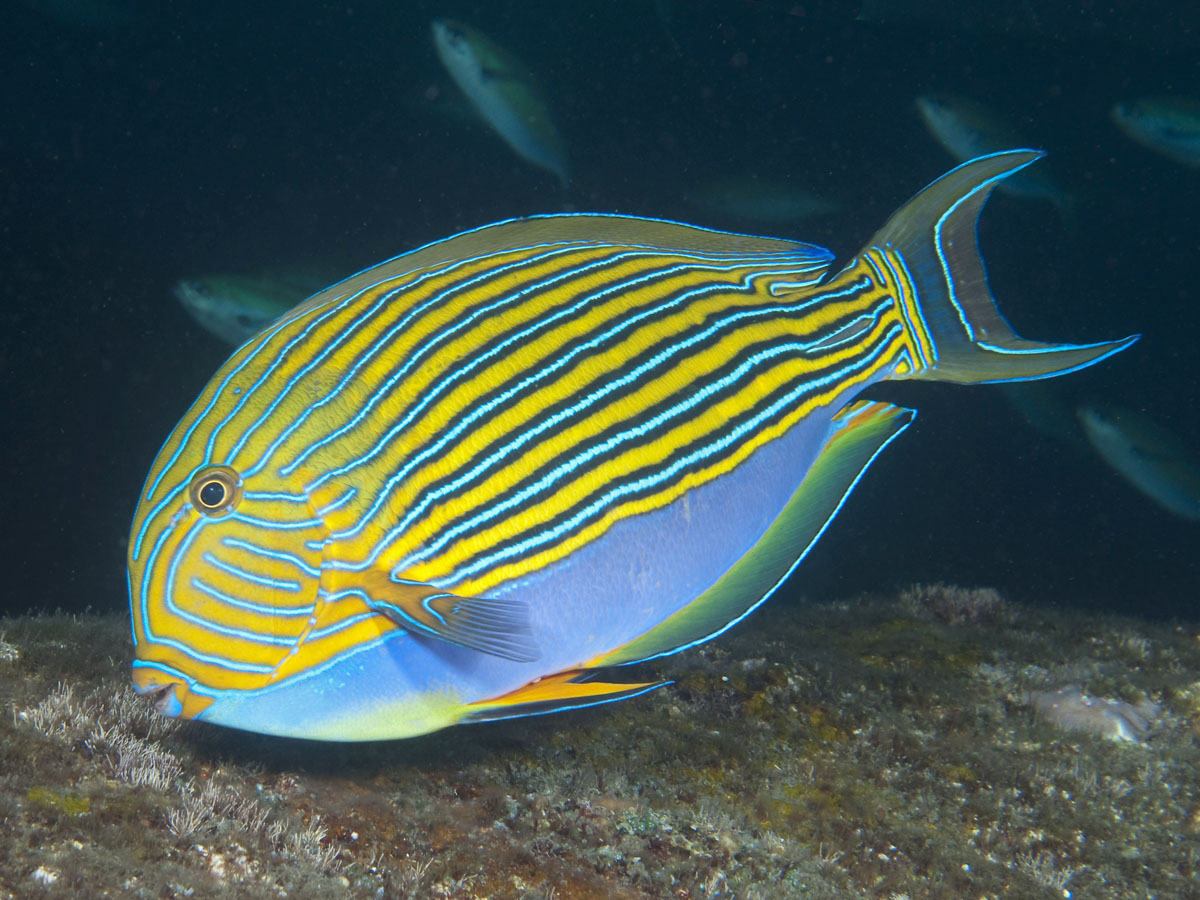
-
Ctenochaetus striatus
Striated surgeonfish
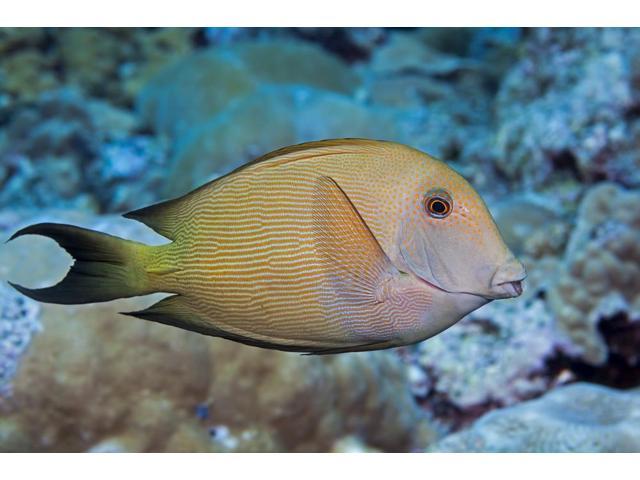
-
Acanthurus nigricans
Whitecheek surgeonfish
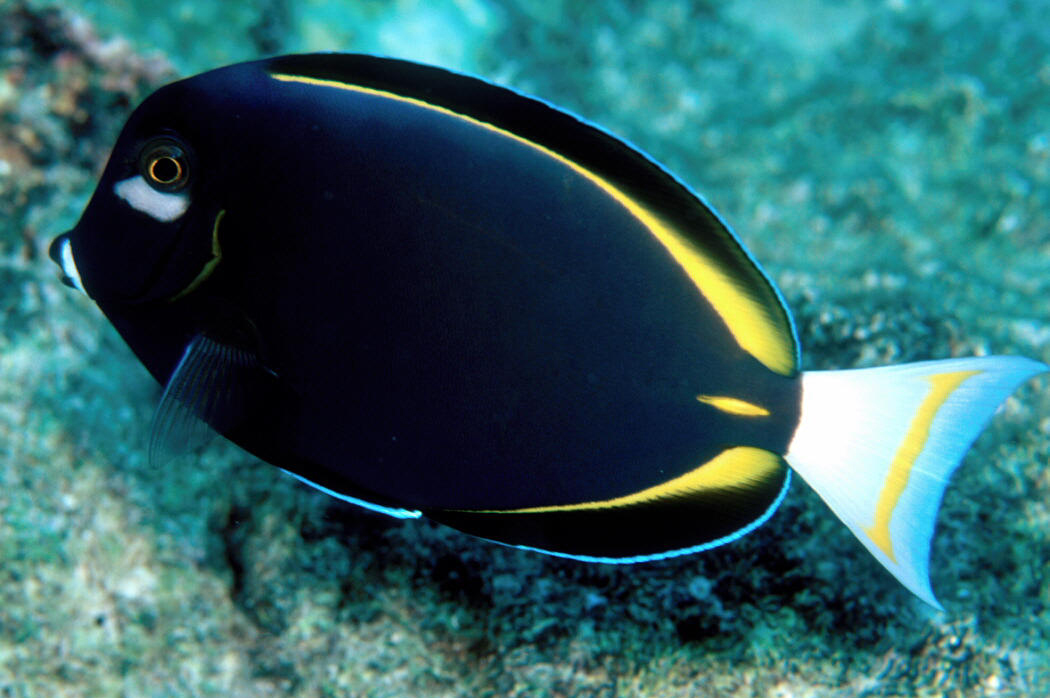
-
teleosts
An infraclass of the class Actinopterygii, this classification includes most ray-finned fishes found in the world today, with only a few exceptions of ancient fish which branched off earlier in evolutionary history.

-
hydrophone
A device used to detect sounds underwater.
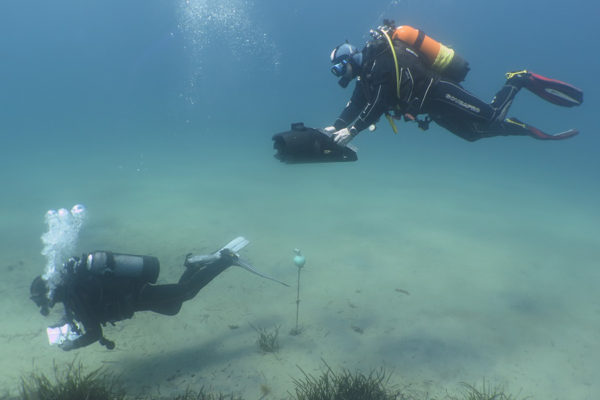
-
gastric motility
Describes the movements of smooth muscle in the stomach that contract as part of the digestion process.
-
tonic immobility
Many animals "play dead" in response to a stress or threat, but this trance-like state in sharks is thought to be connected to mating since they typically have few predators to feel threatened by. It typically takes 15 minutes for this effect to wear off and has little or no lasting health consequences for the shark.

-
V16, V13 and V9 types
The numbers refer to the diameter of the tag, with different sizes being better suited to a range of animal sizes and data types.

-
temporal resolution
How many measurements are made over a period of time. A measurement is said to be continuous if it is being constantly tracked, whereas discrete measurements are taken periodically at a time interval that the scientists have determined is frequent enough to answer their research question.
-
backreefs (2–3 m depth, high vertical relief coral, good visibility) which transition to forereefs
This illustration of the anatomy of a barrier reef shows the relative position and depth of the backreef and forereef to the lagoon found at the center of an atoll:

-
Palmyra
Located in the Pacific, south of Hawaii:
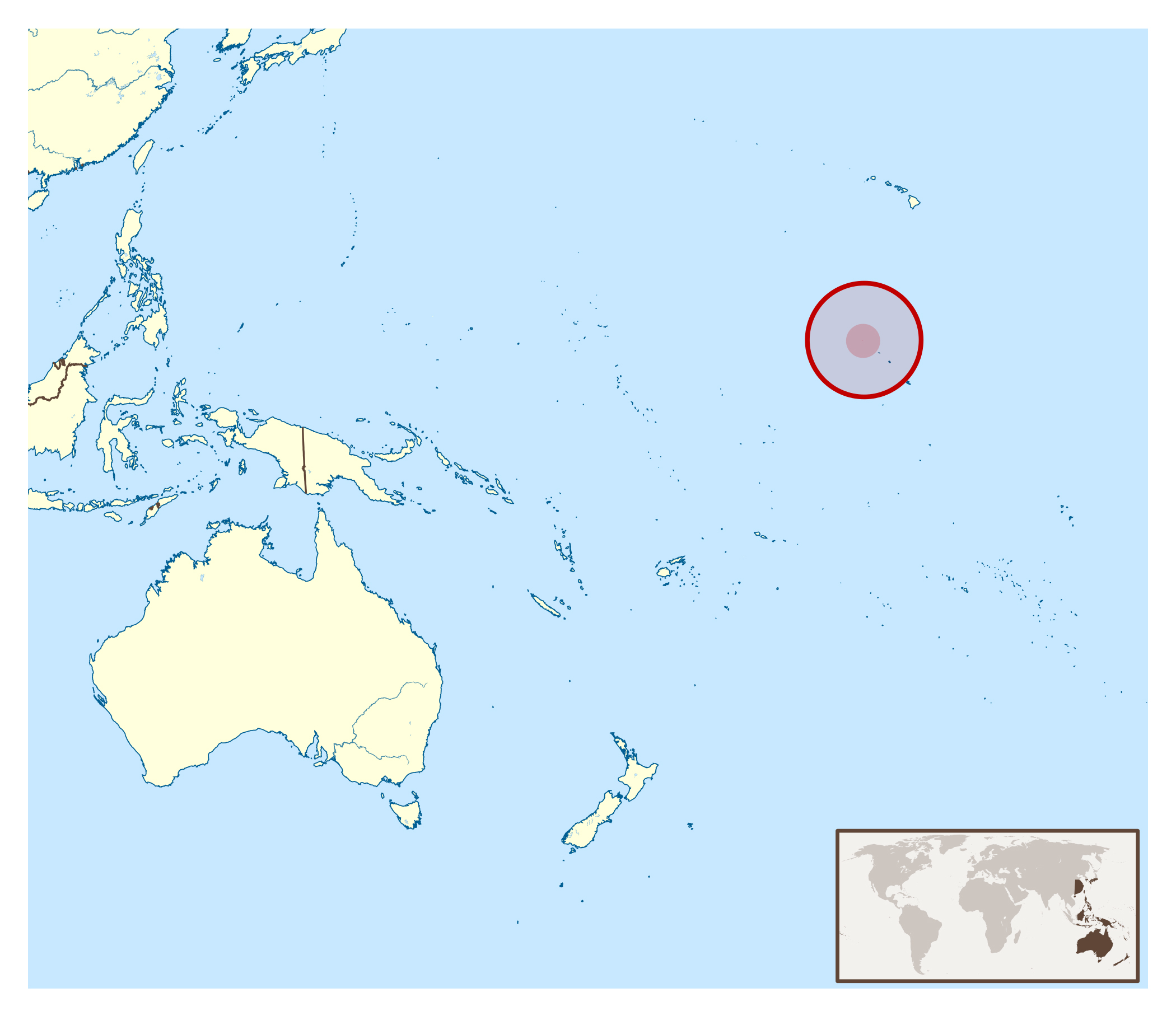 With no permanent residents, this is a United States Minor Outlying Island that is part of the largest marine protected area in the world: the Pacific Remote Islands Marine National Monument.
With no permanent residents, this is a United States Minor Outlying Island that is part of the largest marine protected area in the world: the Pacific Remote Islands Marine National Monument.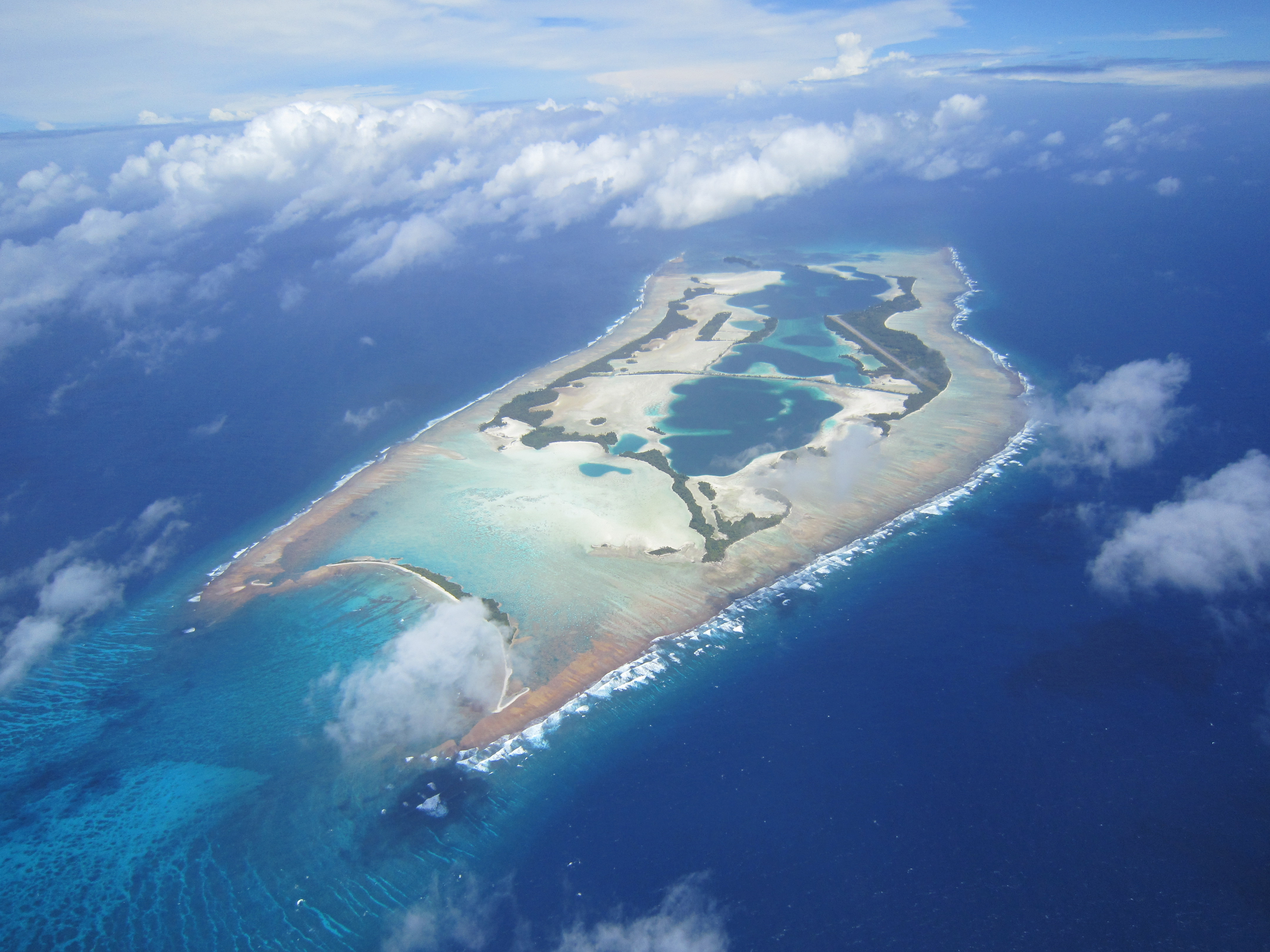
-
behaviourally thermoregulate
Behaviors performed to control the temperature of an organism such as basking in the sun or seeking shelter.
An example of turtles basking in the sun to increase their body temperature:

-
gastric evacuation
The emptying of the stomach which occurs as food moves on to subsequent stages of digestion and the eventual excretion of wastes.
-
thermal niche
The temperature conditions within which an organism has the best chance of thriving. This is one of several factors that determine the ecological niche of an organism, which describes how its behavior and habitat choice play a specific role in the context of the larger ecosystem that it is a part of.
-
Gaussian function
The classic "bell curve" that is used to describe a normal distribution of values.
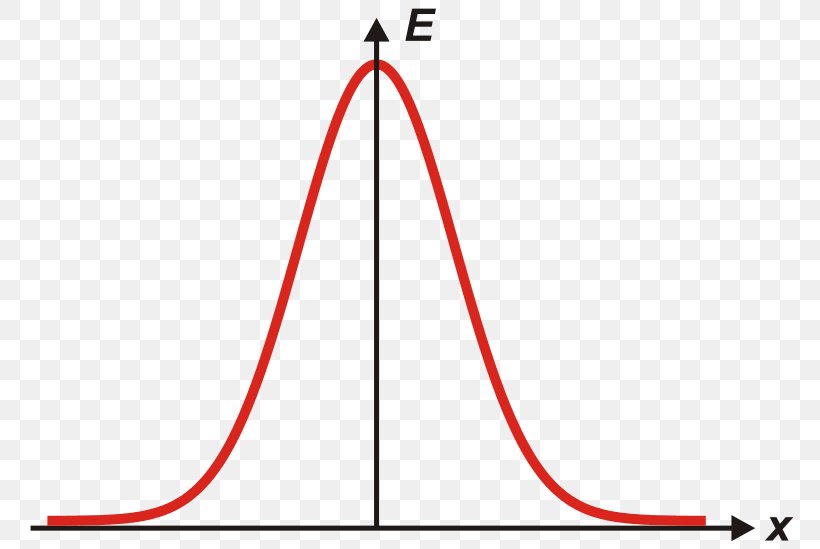
-
enzyme kinematics
Enzymes perform many important functions in our bodies (such as digestion) and have a temperature at which they can perform optimally. Temperatures that are higher or lower will require more energy to perform the same task. Keeping your body, and the enzymes that it contains, at an optimal temperatures is a way to maximize the efficient use of energy.

-
crepuscular
Refers to things that happen during the twilight hours (dawn and dusk). This is in contract to "nocturnal" things that happen at night or "diurnal" things that happen during the day. Crepuscular animals such as deer, bears, and housecats tend to be the most active during these time periods.
-
body condition
A measurement that can be used to infer the health status of an organism. This is typically calculated by comparing a measurement like length to another like weight, for which a healthy ratio is known.
The human body-mass-index (BMI) can be considered a measurement of body condition, as this is derived from a person's height and the range of weights that are considered to be healthy for that height.
A fish with a high body condition is likely to be on the plump side with excess energy stored as a buffer for times of low food intake or high energy use, while a fish with low body condition would be skinny for its length and have low energy reserves.
-
metabolic cost
The energy required for an organism to perform an action. This includes constant needs such as the maintenance of cells or voluntary actions like the use of muscles for swimming. Organisms must balance all of these metabolic costs with the intake of energy from food, or they will run an unsustainable deficit in their energy budget.
-
thermal inertia
Describes the resistance of an object (or, in this case, an animal) to changes in temperature, and the speed at which it approaches the temperature of its surroundings. A warm fish with high thermal inertia would maintain its heat relatively well in cold waters, whereas a fish with low thermal inertia would lose its heat quickly in cold water and is more likely to have a body temperature that is similar to its surroundings.
-
ebbing high tides
The period that follows the high point in the tidal cycle (high tide) as the ebb current pulls water back towards the ocean.

-
diurnal prey
"Diurnal" refers to things that happen during the daytime. This is the opposite of its antonym "nocturnal", which appears much more often in common speech to refer to animals that are active at night. In this case, "diurnal prey" is used to refer to the daytime activity of fish that the sharks may be feeding on.
-
tropical atoll
An island formed when an extinct mid-ocean volcano surrounded by coral reefs is eroded and subsided beneath sea level, leaving only a coral reef ring visible above the ocean surface.
 These are found only in tropical and subtropical regions where corals can thrive and continue to build up a reef at a rate that keeps pace with the erosion and subsidence of the underlying volcano.
These are found only in tropical and subtropical regions where corals can thrive and continue to build up a reef at a rate that keeps pace with the erosion and subsidence of the underlying volcano.

-
-
www.scienceintheclassroom.org www.scienceintheclassroom.org
-
three-point bending test
The three-point bend test provides values for the modulus of elasticity, and flexural stress and strain.
Modulus of elasticity is the ratio of the stress in a body to the corresponding strain.
Flexural stress is the maximum bending stress that can be applied to that material before it breaks.
Flexural Strain is the ratio of stress to strain in flexural deformation, or the tendency for a material to resist bending.
-
poly(anhydride)-based matrices
A class of biodegradable polymers which are characterized by anhydride bonds. In vivo, they degrade into non- toxic monomers that are metabolized and eliminated from the body.
-
injectables
A once a month, or every three month shot that contains a series of hormones designed to stop the body from releasing eggs, and thicken the cervix mucus, thus preventing pregnancy.
-
vaginal rings,
A flexible transparent ring of plastic placed in the vagina and releases estrogen and progestogen. This needs to be replaced once a month.
-
oral pills
A daily pill that consists of progestin and estrogen to prevent pregnancy.
-
human pylorus
The opening from the stomach into the small intestine.
-
transdermal patches
A once-a-week patch that adheres to the skin and releases the necessary hormones to prevent pregnancy.
-
intrauterine devices
Also called an IUD, this device is planted within the uterus in a t- shaped form to prevent pregnancy.
-
subcutaneous implants
A small rod- like implant under the skin of the arm which releases the hormone progestin, to prevent pregnancy.
-
contraceptives
A drug or device used to prevent pregnancy.
-
Poor patient adherence
Women who use daily contraceptives have a lack of commitment to taking their prescribed pill at the same time everyday.
-
hydrolysis
The chemical breakdown of of a compound due to its reaction in the presence of water.
-
Bonferroni
A statistical analysis test used to counteract false positive results within multiple comparisons. It is used when several independent or dependent tests are being performed simultaneously.
-
levonorgestrel
A synthetic steroid hormone that has similar effects on the body to progesterone and is often used in contraceptive pills.
-
elastomeric
An elastic substance occurring naturally or synthetically.
-
poly(caprolactone)
A polymer often used to improve a products processing characteristics, and its compatibility with other materials. It can be used to increase biodegradability, or used with a polymeric to plasticize a product.
-
poly(lactide-co-glycolide)
A copolymer which is widely accepted for biomedical applications due to its biocompatibility, biodegradation rate, approval for clinical use, potential modification properties, and export opportunities to cultures with unpopular use of animal- derived products.
-
-
www.scienceintheclassroom.org www.scienceintheclassroom.org
-
biofabrication
Production of complex living and non-living products from bio-compatible materials and cells to address medical challenges.
-
extracellular matrix
A network of biological materials surrounding cells throughout the body for protection and support.
-
microphysiological devices
Tiny devices that mimic the functions of human physiological systems such as organs and tissues.
-
synchronous
Occurring or existing at the same time.
-
3D Voronoi lattice
A lattice structure is a structure made of crisscross patterns of stripping. A 3D Voronoi lattice is used to help make objects lighter, but stronger.
-
microvascularization
formation of small blood vessels
-
arrhythmogenic disease
Muscle tissue in the heart dies and is replaced with scar tissue. Leads to weakened blood flow and irregular heartbeats.
-
electrophysiologic
Electrical activity of the heart
-
anisotropic
Having a physical property that has different values when measured in different directions.
-
α-actinin
Needed for attachment of actin to Z-lines in skeletal muscle cells.
-
hESC-CMs
Human embryonic stem cell-derived cardiomyocytes
-
angiogenesis
The development of new blood vessels.
-
perivascular
Around a blood vessel.
-
vessel lumens
The inside space of the blood vessel.
-
vasculature
The arrangement of blood vessels in an organ or tissue.
-
-
www.scienceintheclassroom.org www.scienceintheclassroom.org
-
Hanna Basin
Located in present-day Wyoming. Map of the Hanna Basin: https://www.wsgs.wyo.gov/docs/wsgs-web-hanna-basin-geologic-map.pdf
-
Carsioptychus
Image of Carsioptychus coarctatus provided by HHMI Tangled Bank Studios shows a rendering of this ancient herbivorous mammal. https://durangoherald.com/articles/300859
-
periptychid mammals
Known only to exist in North America, these placental mammals are readily identified by their unique teeth.
-
baenid turtles
This is an extinct clade of turtles that appeared during the Jurassic and disappeared in the Eocene.
-
hydroxyapatite
The calcium compound that is the main inorganic component of tooth enamel and bones. It gives bones and teeth rigidity.
-
Lancian mammal
The Cretaceous land mammal stage dating from 70 Ma to 66 Ma.
-
ecosystem equilibrium
Population sizes are stable and remain within a sustainable range. They are in balance.
-
lithostratigraphic log
This is a graphic way to represent the succession of layers over time.
-
biotic
These are the living components of an ecosystem and includes the autotrophs, heterotrophs, and detritivores.
-
“Earth system succession”
This occurs when biotic and/or abiotic change results in the biosphere or geosphere becoming unbalanced. It provides a way to explain the ecological and evolutionary changes observed in the fossil record.
-
co-evolution
This occurs when two or more species affect the evolution of each other.
-
ungulate Eoconodon coryphaeus
This is an extinct species of hoofed, placental mammals. They are the largest known species of the genus.
-
paleotemperature proxies
Fossils/imprints from the past, referred to as proxies, can be used to determine what the paleoclimate was like. Examples of proxies are coral, pollen, and tree rings. These are analyzed and correlated with current climate conditions.
-
Leaf mass per area (LMA)
This is a morphological trait used as an indicator of the rates of photosynthesis and respiration. It is a way to link light capture to growth and carbon gain.
-
speciose
Many examples of members of the same genus are present. The area is species-rich.
-
distal
This is the outer regions of the floodplain.
-
Ectoconus ditrigonus
These were herbivorous mammals.
-
in situ
The saplings are located in their original place.
-
articulated
A skeleton that is all in one piece with the bones arranged in the correct order.
-
Leaf-estimated mean annual temperature
The physical traits of leaves, their morphology, is used to estimate the temperature.
-
morphospecies
A taxonomic species based only on its physical (morphological) differences from related species.
-
dicot
Flowering plants that have two seed leaves, or cotyledons, in the seed embryo.
-
juglandaceous
Pollen produced by members of the walnut plant family.
-
fluvial facies
Units of sediments deposited by rivers that have similar characteristics based on bedding and texture.
-
intercalated
The interbedding of two distinctly different depositional environments.
-
palynostratigraphic biozones
The analysis of spores, pollen, and other particulate organic matter in sedimentary rock.
-
Ma
The Ma label is the abbreviation for mega annum and signifies time in millions of years.
-
Geomagnetic Polarity Time Scale
Earth's north and south magnetic poles have reversed multiple times. Normal polarity occurs when the magnetic north points toward the geographic north pole. The reverse is the opposite. A record of the onset and duration of these reversals has been measured back to the Upper Jurassic.
-
San Juan Basin
This basin is located in northern New Mexico and southern Colorado.
-
outcrops
This is an area where the underlying rocks are exposed.
-
angiosperms
These are plants that flower and fruit. They produce seeds enclosed within a female reproductive structure. It includes many non-woody plants, shrubs, and trees.
-
crown birds
This is a clade that includes all living bird species and their ancestors, back to the common ancestor and all of the ancestor's descendants that did not evolve to form modern species.
-
clades
This is a grouping of organisms that includes a single common ancestor and all the species descending from that ancestor, both living and extinct.
-
radiation
The proliferation of species from a single ancestor and their diversification into ecologically different forms.
-
terrestrial
This refers to things related to the land as opposed to aquatic or marine.
-
non-avian dinosaurs
These are cold-blooded dinosaurs, not related to birds.
-
Leguminosae
This refers to a family of plants that have nodules on their roots that contain nitrogen-fixing bacteria. The bacteria transform atmospheric nitrogen gas into nitrogen compounds plants are able to use.
-
megafloral
This term refers to large plant species.
-
niche
This is how an organism fits into the ecosystem—the role it plays. It is how it interacts with other species in a biological community.
-
taxonomic richness
The number of different species represented in an ecological community. It is not a count of the number of members of each species, but of the diversity of species present.
-
drivers
Factors that cause an event or phenomenon to occur.
-
elucidates
A term used when something that was confusing is made clear.
-
-
www.scienceintheclassroom.org www.scienceintheclassroom.org
-
lithophile elements
The term lithophile was coined by Goldschmidt to describe elements with affinity for silicates. The Greek word lithophile means rock-loving. These elements are primarily found in regions with higher concentrations of silicate, e.g., the mantle and crust. A few examples of lithophile elements are Li, Na, Mg, Al and Si.
-
δ13C-δ18O
The term ‘δ<sup>13</sup>C-δ<sup>18</sup>O’ denotes the isotopic signatures of carbon and oxygen elements. An isotopic signature is calculated from the ratio of stable isotopes (13-C/12-C or 18-O/16-O) and expressed in parts per thousand.
-
trace-element
A chemical element which constitutes less than 0.1% of a rock's composition.There is unique geochemical information stored in the variation of concentration of each trace element. Zn, Cd and Sr are a few examples of trace-elements.
-
sublithospheric diamonds
Identified by mineral inclusions consistent with being exposed to high pressures found at depths of more than 400 kilometers.
-
Sr-Nd-Hf-Pb
Strontium-Neodymium-Hafnium-Lead
-
transition zone
The area that separates the Earth's upper mantle from its lower mantle. The depth of this zone is usually between 410 to 660 kilometers beneath the Earth's surface.
-
fluid inclusions
Small quantities of gases or liquids that remain trapped inside minerals. These inclusions provide critical insights on the geological processes in the Earth's interior.
-
superdeep
At depths of more than 410 kilometers underneath the Earth's surface.
-
He-Sr-Pb
Helium-Strontium-Lead
-
reservoirs
Refers to a mass of material that experiences a common set of chemical interactions. Reservoirs, in most cases, have distinct boundaries (e.g., an ocean).
-
Isotope
Chemical elements that have the same number of electrons and protons but a different number of neutrons are called isotopes. For example, both carbon-12 and carbon-14 have six electrons and six protons, but they have 12 and 14 neutrons, respectively. These isotopic differences change the atom's atomic mass and other chemical properties.
-
